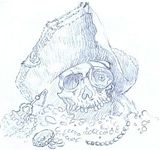http://www.poewar.com/creating-memorable-characters/
http://www.poewar.com/dear-john-how-do-you-write-a-role-playing-character-biography/
Información:
How to Create Fictional Characters
When writing fiction, one of the greatest challenges is to come up with compelling characters that both interest the reader and fit the story. On the surface, fitting the story might seem like the lesser of the two considerations, but it really isn’t. Beyond being interesting, the character must also be the type of person who will respond to your plot. Whatever the action of your story is, it needs to matter to your characters. The reader (and you) must care about what is happening to a character and take interest in what the character will do, or will fail to do.
Most people’s inspiration for a character begins with some spark. The spark may come from anywhere. It could be a voice, a physical feature, a profession, a line of dialog, or a plot you want your character involved in. Whatever the spark is, you need to need to explore it. You should expand upon that voice, that physical feature, that dialog, that profession or that plot. Whatever the first spark of life is, expand upon it until it fully takes shape.
After you have moved beyond the original spark, you need to create a profile of your character. You should start out very simply. Is the character male or female? How old is the character? How does the character look? What kind of clothes does the character wear? Is the character generally happy, sad, angry, lonely or indifferent? These are all very basic questions, but it is surprising how often they are ignored.
Next, explore the character’s background. Is the character working, getting an education or doing something else that occupies their time? Where does the character live? What is the character’s family like? What kind of friends does the character have? What kind of things does the character own? That last question can be surprisingly informative. You can approach it from several angles. What is in the character’s home? What is in the character’s office at work? What is in the character’s pockets or purse? How many keys does that character have and to what?
Once you have put the larger pieces of the character’s personality and life together, it is a good time to pick a name. You should now know who they are and what they are like. Knowing your character increases your ability to give them a name that fits them. Names should match the character, but without being clich’. A boxer named “Punch” is a little silly, for example. Of course, a nickname may spring up that mirrors the character’s personality, but their given name should only suit the character, not stereotype them. Whole volumes can be written on naming characters alone, but suffice to say that buying a book of baby names and going through it until you find one that feels good will work.
You can try all sorts of additional ways to delve deeper into your character. Interviewing the character is a good exercise. Ask the character questions as if you are a reporter for Rolling Stone, People, the local newspaper or a magazine appropriate to your character’s background. Let the character speak. If you have already developed other characters for your story, ask them about your character. What do the other characters think about this person? Do they see the character differently than the character sees himself or herself?
Another way to explore your characters is to visualize them in their everyday world. What route do they take to work? What stations do they pick out on the radio? How do they act at a party? How do they respond to their boss or to their parents? What are their most common facial expressions? What are their hobbies? What household chores do they perform or ignore? What are their finances like? Picture the character five or ten years before the story takes place and five or ten years in the future. Where have they come from and how will the circumstances of your story change them?
Once you have explored your character in detail, you need to finish by creating a short, clear portrait of that character. What makes the character interesting, compelling and different? Try to come up with both a single sentence character description and a single paragraph character description. Each of these descriptions should vividly portray what kind of person this is. You won’t necessarily use these descriptions in your story, but it is important to have a clear portrait of your character that can guide you as you write and the story progresses.
After you have created your character, it is important to remember that they must be treated as individuals with their own needs and agendas. Allow your characters to have secrets, quirks and contradictions. Most people have a thousand little contradictions, even if their basic nature remains steadfast. Do not, however, make a character violate their basic nature just to suit the plot. If this character’s actions would change your plot too much, you need to either re-examine the plot, or create a more suitable character.
The most important advice I can give you is to respect your characters. Treat them as important people, whether you like the individual character’s personality or not. Remember that the character’s feelings and actions must reflect who they are and that the progression of the story must be important to them. What happens to them must matter. If you don’t find your character compelling and worthy of exploration, how can you expect a reader to?








No hay comentarios:
Publicar un comentario